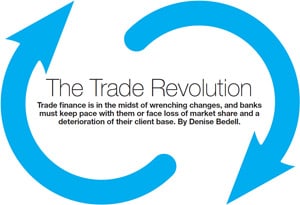SIBOS 2011— TRADE FINANCE
By Denise Bedell
Trade finance is in the midst of wrenching changes, and banks must keep pace with them or face loss of market share and a deterioration of their client base.

The demands of traders, from small outfits to the largest multinationals, are increasing. They want more-sophisticated and automated solutions, while still needing or desiring access to traditional trade finance instruments. Plus, a new breed of multinational is developing in the emerging markets, and their trade finance needs can be quite different from those of their compatriots in more-developed markets.
Trade banks must not only address the expectations of such a diverse client base but also prepare for the effects of new regulations on their trade finance activities—not least Basel III, which promises much-increased costs and complexity for trade finance operations. The new regulations are prompting concern over how banks’ leverage ratios will reflect their trade finance activities and whether trade finance will be affected by Basel III’s treatment of off-balance-sheet instruments.
If trade finance activities end up being 100% risk-weighted and treated in the same manner as other off-balance-sheet instruments under the new regulations, it will drastically increase costs for banks, which will trickle down to company costs for financing global trade. It will also likely lead to further consolidation in the trade finance sector.
“For banks, automation is key to speeding up the processing of traditional trade finance”
“Banks are working toward enhancing electronic delivery and receipt mechanisms for managing trade finance flows” – Gareth Watts, BoAML
Increasingly Sophisticated Demands
In the developed world, the global financial crisis triggered a spike in the use of traditional trade finance instruments, in part because multilateral agencies relied upon letters of credit as their primary mechanism to provide financing support. In many cases, transactions in the emerging markets that were previously on open account terms reverted to letters of credit to gain the benefit of the advantageous financing.
That trend has since tailed off to some extent, and the trend toward open account is resuming. Multinationals still want banks to support traditional instruments, but they also want their trade finance banks to provide much more sophisticated solutions to support increasingly sophisticated supply chains.
Michael Quinn, managing director at J.P. Morgan Treasury Services, says that companies now have much more information about counterparties that, coupled with more-advanced technology, means they have less need for traditional paper-based documentary instruments that often cause as much disruption as facilitation. Quinn notes: “At times, companies need risk mitigation, and more frequently, they need access to financing for themselves or their counterparties, but they won’t sacrifice efficiency in supply chains to get it.”
In addition, banks are working on adding services relating to trade finance management, for example by connecting supply-chain finance programs to trade finance solutions. They are also offering to outsource non-core processes such as document preparation, electronification and transmission.
“Companies need risk mitigation, and more frequently, they need access to financing”
However, “they won’t sacrifice efficiency in supply chains to get it”
– Michael Quinn, J.P. Morgan Treasury Services
A New Breed of Multinational
Meanwhile, there is a whole subgroup of multinationals coming from emerging markets with different trade finance needs than traditional multinationals from developed markets. Global trade banks must not only support the requirements of their developed-world clients but also adapt to the unique needs of this new client base.
Craig Weeks, head of trade product sales for global transaction services at Citi, says: “They require a different infrastructure from their banks. They have different local requirements for export processes and importing needs and expect their bank to understand how complex trade transactions must be structured in their market. Banks must understand their needs and how to service them.”
They are also dealing with high costs for trade finance instruments, costs that are hampering growth. The International Chamber of Commerce’s (ICC’s) Trade and Finance Global Survey 2011 found that in many low-income countries, traders still have considerable difficulty accessing affordable trade finance, particularly for import finance. The survey noted: “One positive development is that the average price for letters of credit in large, emerging economies fell from 150-250 basis points in 2009 to 70-150 basis points in 2010.”
However, the ICC also reported that the cost of trade remains high in much of Asia and throughout Latin America. Given the growing significance of these regions on the world economic stage, developing lower-cost trade finance options and specifically geared solutions will be important in sustaining the growth of global trade.
Traditional trade finance instruments are essential to these markets. “Country regulations in such countries (and, indeed, in developed countries) require documentary instruments for foreign exchange or registration purposes, for example,” says Quinn. “Also, in small, underdeveloped countries there is no infrastructure to support technology-enabled supply chains, further necessitating documentary instruments.”
For both the developed and developing world, there is a desire for lower-cost, more-efficient solutions to manage trade finance operations. Companies, whether they are in Hong Kong or Canada, want to speed up processing time for document transfer and don’t want to pay a fortune to manage global trade. Gareth Watts, senior trade product manager at Bank of America Merrill Lynch, says: “For banks, automation is key to speeding up the processing of traditional trade finance instruments and reducing cost.” Corporates are looking for an improvement in information flow and visibility of all transactions.
Watts adds: “Banks are working toward enhancing electronic delivery and receipt mechanisms for managing trade finance flows, both through proprietary systems for direct clients and through broader industry-standard mechanisms that are being developed,” he says, pointing to multibank trade finance platforms as an example.
The continuing growth of industry solutions, such as multibank platforms or the Trade Service Utility (TSU) with the Bank Payment Obligation (BPO) option from SWIFT, could help smaller or less-sophisticated trade banks stay in the game. In fact, the BPO from SWIFT, which is essentially a new financing instrument that works like an automated letter of credit, could bridge the gap between old and new trade finance tools. Gareth Lodge, a senior analyst at consultancy Celent, says: “The trick will be to bring the best bits of the old L/C [letter of credit] but apply the latest technology.”
But adoption of multibank platforms and the TSU has been slow, and both banks and corporates need to push these initiatives further before they present a real solution to the growing complexities of global trade. The key for trade banks will be to maintain—or develop—the flexibility to provide highly advanced solutions as well as to support the unique situations of their clients. Rick Striano, regional product head of Americas in trade and financial supply chain for Deutsche Bank’s global transaction banking division, says the volatility in the market has brought many clients back to their trade bankers for guidance on alternative solutions. “Many of the deals we do today are a creative mix of new and old products, ideas and instruments blended to address a specific transactional concern of the client.”
|
|
||




